Investigative Spatial Distribution and Modelling of Existing and Future Urban Land Changes and Its Impact on Urbanization and Economy
Abstract
1. Introduction
2. Study Area and Data
2.1. Study Area
2.2. Satellite Image Acquisition
3. Methods
3.1. Satellite Image Pre-Processing
3.2. Development of LULC Maps and Spatio-Temporal Analysis
3.3. Future Prediction of LULC Changes
4. Results
4.1. Land Cover Classification and Spatio-Temporal Analysis
4.2. Transformation Analysis and Future Prediction of LULC Changes
5. Discussion
5.1. Accuracy of LULC Maps
5.2. Impact of LULC Changes on Urbanization and Economy
6. Conclusions
Author Contributions
Funding
Acknowledgments
Conflicts of Interest
References
- Gumma, M.K.; Mohammad, I.; Nedumaran, S.; Whitbread, A.; Lagerkvist, C.J. Urban Sprawl and Adverse Impacts on Agricultural Land: A Case Study on Hyderabad, India. Remote Sens. 2017, 9, 1136. [Google Scholar] [CrossRef]
- Song, J.; Lin, T.; Li, X.; Prishchepov, A.V. Mapping Urban Functional Zones by Integrating Very High Spatial Resolution Remote Sensing Imagery and Points of Interest: A Case Study of Xiamen, China. Remote Sens. 2018, 10, 1737. [Google Scholar] [CrossRef]
- Jia, Y.; Ge, Y.; Ling, F.; Guo, X.; Wang, J.; Wang, L.; Chen, Y.; Li, X. Urban Land Use Mapping by Combining Remote Sensing Imagery and Mobile Phone Positioning Data. Remote Sens. 2018, 10, 446. [Google Scholar] [CrossRef]
- Bhatta, B. Analysis of Urban Growth and Sprawl from Remote Sensing Data. Available online: https://bit.ly/2RdOeWa (accessed on 9 January 2019).
- Gbanie, S.P.; Griffin, A.L.; Thornton, A. Impacts on the Urban Environment: Land Cover Change Trajectories and Landscape Fragmentation in Post-War Western Area, Sierra Leone. Remote Sens. 2018, 10, 129. [Google Scholar] [CrossRef]
- Rimal, B.; Zhang, L.; Keshtkar, H.; Haack, B.N.; Rijal, S.; Zhang, P. Land Use/Land Cover Dynamics and Modeling of Urban Land Expansion by the Integration of Cellular Automata and Markov Chain. ISPRS Int. J. Geo-Inf. 2018, 7, 154. [Google Scholar] [CrossRef]
- Hegazy, I.R.; Kaloop, M.R. Monitoring urban growth and land use change detection with GIS and remote sensing techniques in Daqahlia governorate Egypt. Int. J. Sustain. Built Environ. 2015, 4, 117–124. [Google Scholar] [CrossRef]
- Yuan, F. Land-cover change and environmental impact analysis in the Greater Mankato area of Minnesota? using remote sensing and GIS modelling. Int. J. Remote Sens. 2008, 29, 1169–1184. [Google Scholar] [CrossRef]
- Rouse, J.W.; Haas, R.H.; Schell, J.A.; Deering, D.W. Monitoring vegetation systems in the Great Plains with ERTS. In 3rd ERTS Symposium; NASA SP-351 I; Remote Sensing Center, Texas A&M University: College Station, TX, USA, 1973; pp. 309–317. [Google Scholar]
- Huete, A.R. A soil-adjusted vegetation index (SAVI). Remote Sens. Environ. 1988, 25, 295–309. [Google Scholar] [CrossRef]
- Zha, Y.; Gao, J.; Ni, S. Use of normalized difference built-up index in automatically mapping urban areas from TM imagery. Int. J. Remote Sens. 2003, 24, 583–594. [Google Scholar] [CrossRef]
- Xu, H. A new index for delineating built-up land features in satellite imagery. Int. J. Remote Sens. 2008, 29, 4269–4276. [Google Scholar] [CrossRef]
- Xu, R.; Lin, H.; Lü, Y.; Luo, Y.; Ren, Y.; Comber, A. A Modified Change Vector Approach for Quantifying Land Cover Change. Remote Sens. 2018, 10, 1578. [Google Scholar] [CrossRef]
- Bonafoni, S.; Keeratikasikorn, C. Land Surface Temperature and Urban Density: Multiyear Modeling and Relationship Analysis Using MODIS and Landsat Data. Remote Sens. 2018, 10, 1471. [Google Scholar] [CrossRef]
- Thanh Noi, P.; Kappas, M. Comparison of Random Forest, k-Nearest Neighbor, and Support Vector Machine Classifiers for Land Cover Classification Using Sentinel-2 Imagery. Sensors 2018, 18, 18. [Google Scholar] [CrossRef] [PubMed]
- Hasan, S.; Deng, X.; Li, Z.; Chen, D. Projections of Future Land Use in Bangladesh under the Background of Baseline, Ecological Protection and Economic Development. Sustainability 2017, 9, 505. [Google Scholar] [CrossRef]
- Kumar, S.; Radhakrishnan, N.; Mathew, S. Land use change modelling using a Markov model and remote sensing. Geomatics, Natural Hazards and Risk 2013, 5, 145–156. [Google Scholar] [CrossRef]
- Pijanowski, B.; Brown, D.; Shellito, B.; Manik, G. Using neural networks and GIS to forecast land use changes: A Land Transformation Model. Comput. Environ. Urban Syst. 2002, 26, 553–575. [Google Scholar] [CrossRef]
- Sang, L.; Zhang, C.; Yang, J.; Zhu, D.; Yun, W. Simulation of land use spatial pattern of towns and villages based on CA–Markov model. Math. Comput. Model. 2011, 54, 938–943. [Google Scholar] [CrossRef]
- Han, H.; Yang, C.; Song, J. Scenario Simulation and the Prediction of Land Use and Land Cover Change in Beijing, China. Sustainability 2015, 7, 4260–4279. [Google Scholar] [CrossRef]
- Jeon, S.; Hong, H.; Kang, S. Simulation of Urban Growth and Urban Living Environment with Release of the Green Belt. Sustainability 2018, 10, 3260. [Google Scholar] [CrossRef]
- Maktav, D.; Erbek, F.; Jürgens, C. Remote sensing of urban areas. Int. J. Remote Sen. 2005, 26, 655–659. [Google Scholar] [CrossRef]
- Qureshi, A.S.; Sayed, A.H. Situation Analysis of Water Resources of Lahore: Establishing a Case for Water Stewardship Pakistan; World Wild Life Fund: Lahore, Pakistan, 2014; p. 3. [Google Scholar]
- Pakistan Bureau of Statistics (PBS). District wise Census Results Census 2017; 6th Population and Housing Census; Statistic House: Islamabad, Pakistan, 2017.
- National Aeronautics and Space Administration (NASA). Landsat 7 Science Data Users Handbook; National Aeronautics and Space Administration: Washington, DC, USA, 2011.
- Chander, G.; Markham, B. Revised Landsat-5 TM radiometric calibration procedures and post calibration dynamic ranges. IEEE Trans. Geosci. Remote Sens. 2003, 41, 2674–2677. [Google Scholar] [CrossRef]
- National Aeronautics and Space Administration (NASA). Landsat 8 Science Data Users Handbook; National Aeronautics and Space Administration: Washington, DC, USA, 2016. [Google Scholar]
- Shirazi, S.A.; Kazmi, S.J.H. Analysis of Population Growth and Urban Development in Lahore-Pakistan using Geospatial Techniques: Suggesting. South Asian Stud. 2014, 29, 269–280. [Google Scholar]
- Remote Sensing Phenology NDVI the Foundation. Available online: https://phenology.cr.usgs.gov/ndvi_foundation.php (accessed on 11 December 2018).
- Tang, K.; Zhu, W.; Zhan, P.; Ding, S. An Identification Method for Spring Maize in Northeast China Based on Spectral and Phenological Features. Remote Sens. 2018, 10, 193. [Google Scholar] [CrossRef]
- Pun, M.; Mutiibwa, D.; Li, R. Land Use Classification: A Surface Energy Balance and Vegetation Index Application to Map and Monitor Irrigated Lands. Remote Sens. 2017, 9, 1256. [Google Scholar] [CrossRef]
- Kong, F.; Li, X.; Wang, H.; Xie, D.; Li, X.; Bai, Y. Land Cover Classification Based on Fused Data from GF-1 and MODIS NDVI Time Series. Remote Sens. 2016, 8, 741. [Google Scholar] [CrossRef]
- Qiao, H.; Wu, M.; Shakir, M.; Wang, L.; Kang, J.; Niu, Z. Classification of Small-Scale Eucalyptus Plantations Based on NDVI Time Series Obtained from Multiple High-Resolution Datasets. Remote Sens. 2016, 8, 117. [Google Scholar] [CrossRef]
- Dadhich, P.N.; Hanaoka, S. Remote sensing, GIS and Markov’s method for land use change detection and prediction of Jaipur district. J. Geomat. 2010, 4, 9–15. [Google Scholar]
- Jianping, L.I.; Bai, Z.; Feng, G. RS and GIS-supported forecast of grassland degradation in southwest Songnen plain by Markov model. Geo-Spat. Inf. Sci. 2005, 8, 104–106. [Google Scholar] [CrossRef]
- Bhaduri, B.; Bright, E.; Coleman, P.; Urban, M.L. LandScan USA: A high-resolution geospatial and temporal modeling approach for population distribution and dynamics. GeoJournal 2007, 69, 103–117. [Google Scholar] [CrossRef]
- Economy of Lahore. Available online: https://en.wikipedia.org/wiki/Economy_of_Lahore (accessed on 11 December 2018).
- Zhou, D.; Xiao, J.; Bonafoni, S.; Berger, C.; Deilami, K.; Zhou, Y.; Frolking, S.; Yao, R.; Qiao, Z.; Sobrino, J.A. Satellite Remote Sensing of Surface Urban Heat Islands: Progress, Challenges, and Perspectives. Remote Sens. 2019, 11, 48. [Google Scholar] [CrossRef]
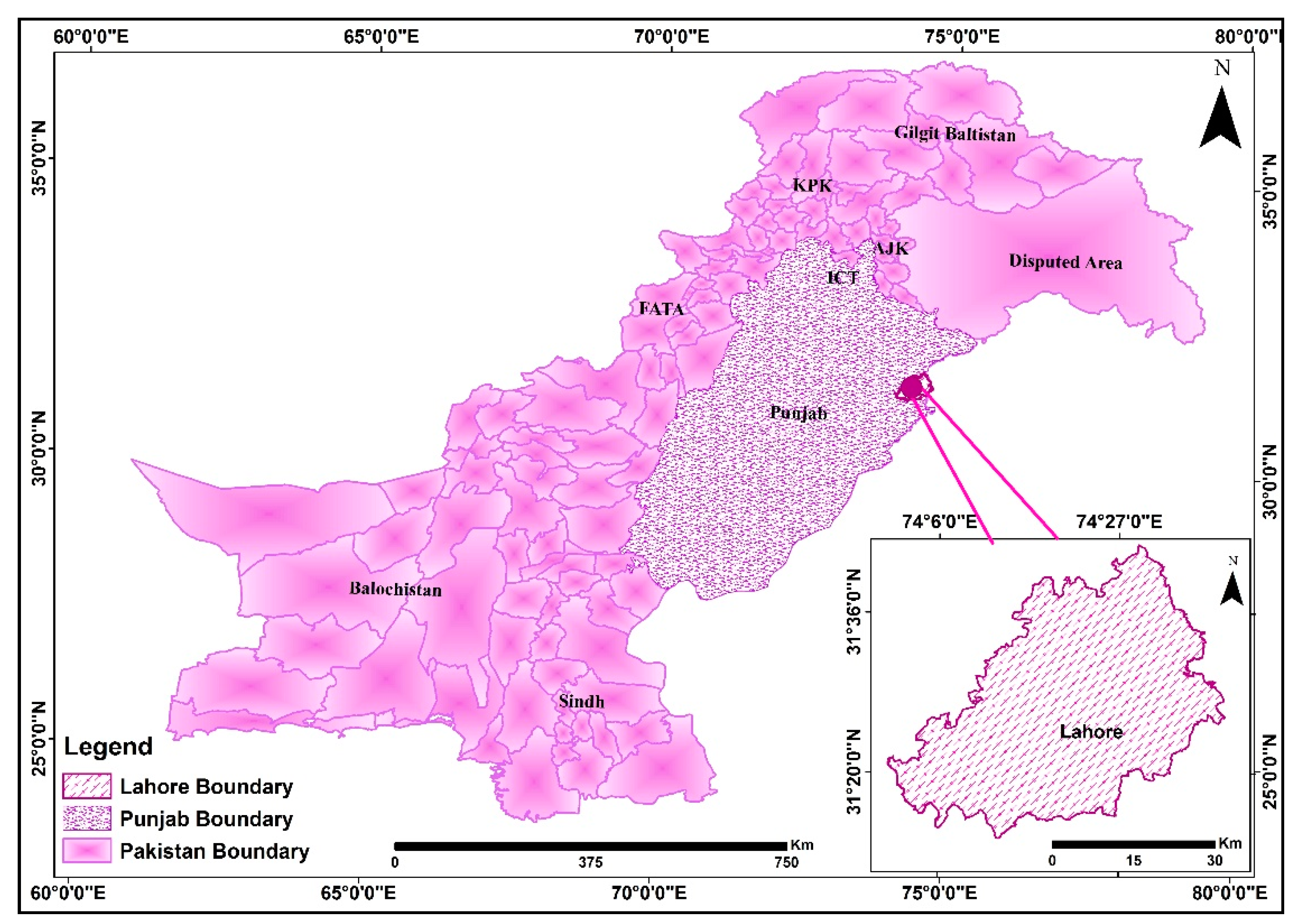
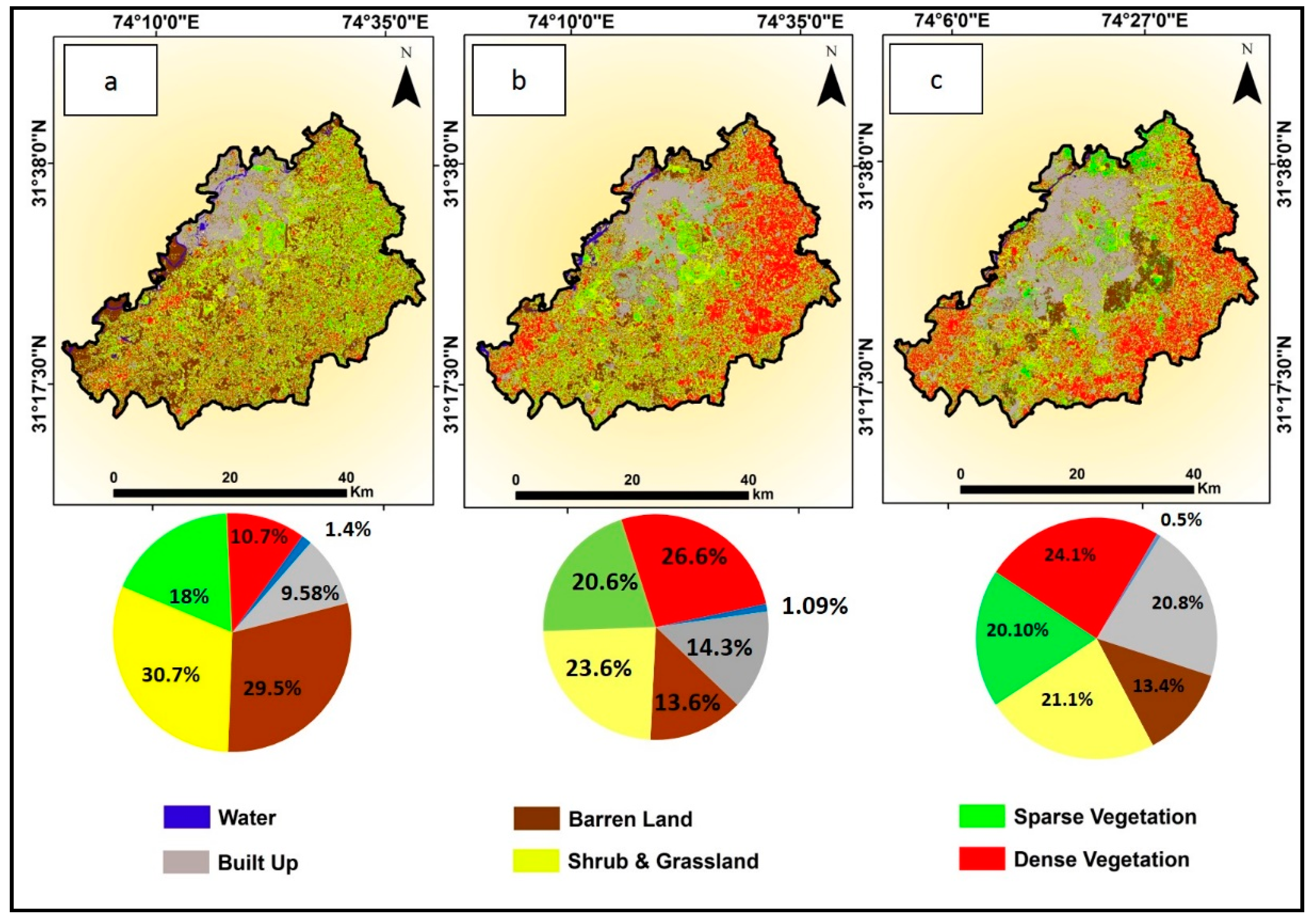
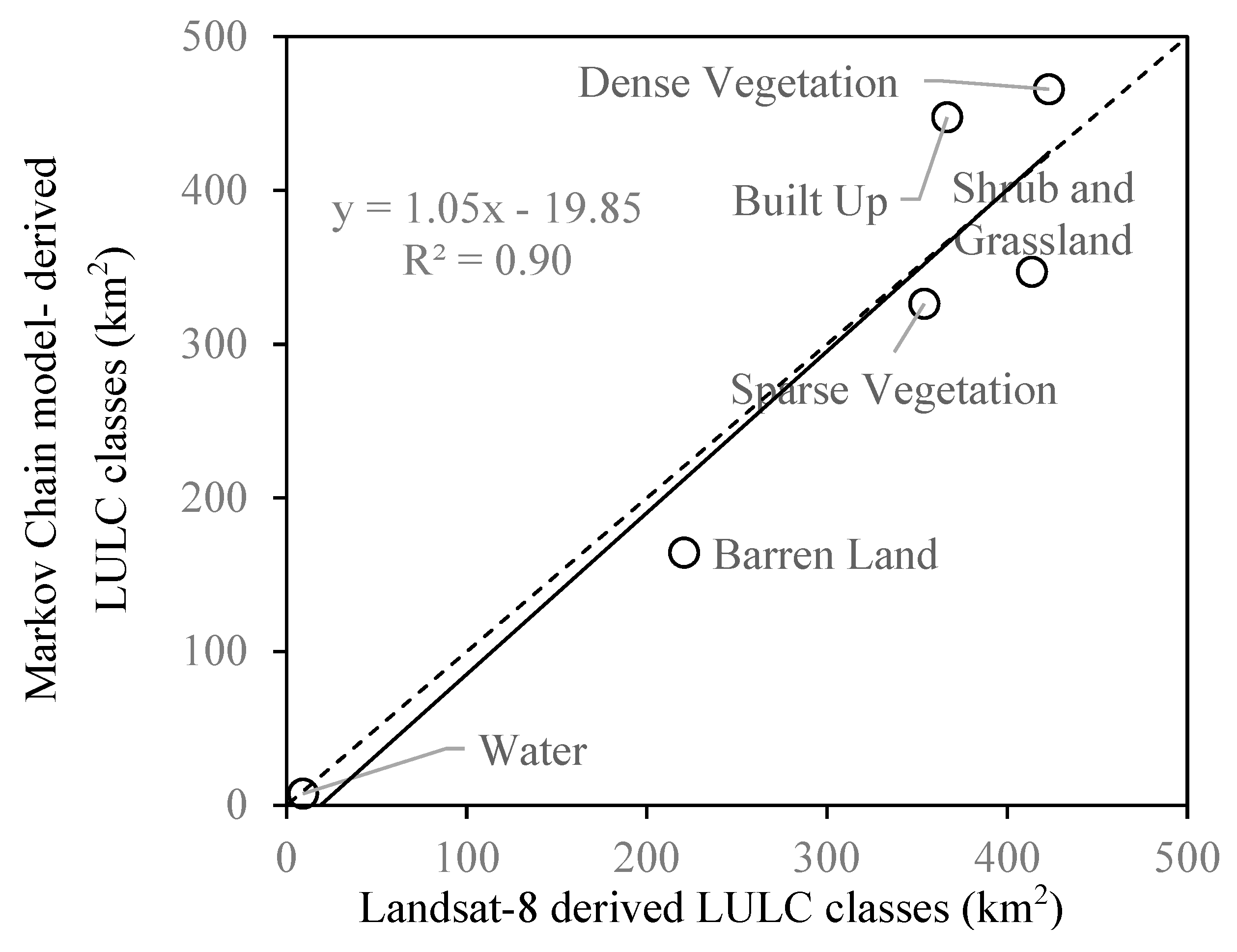
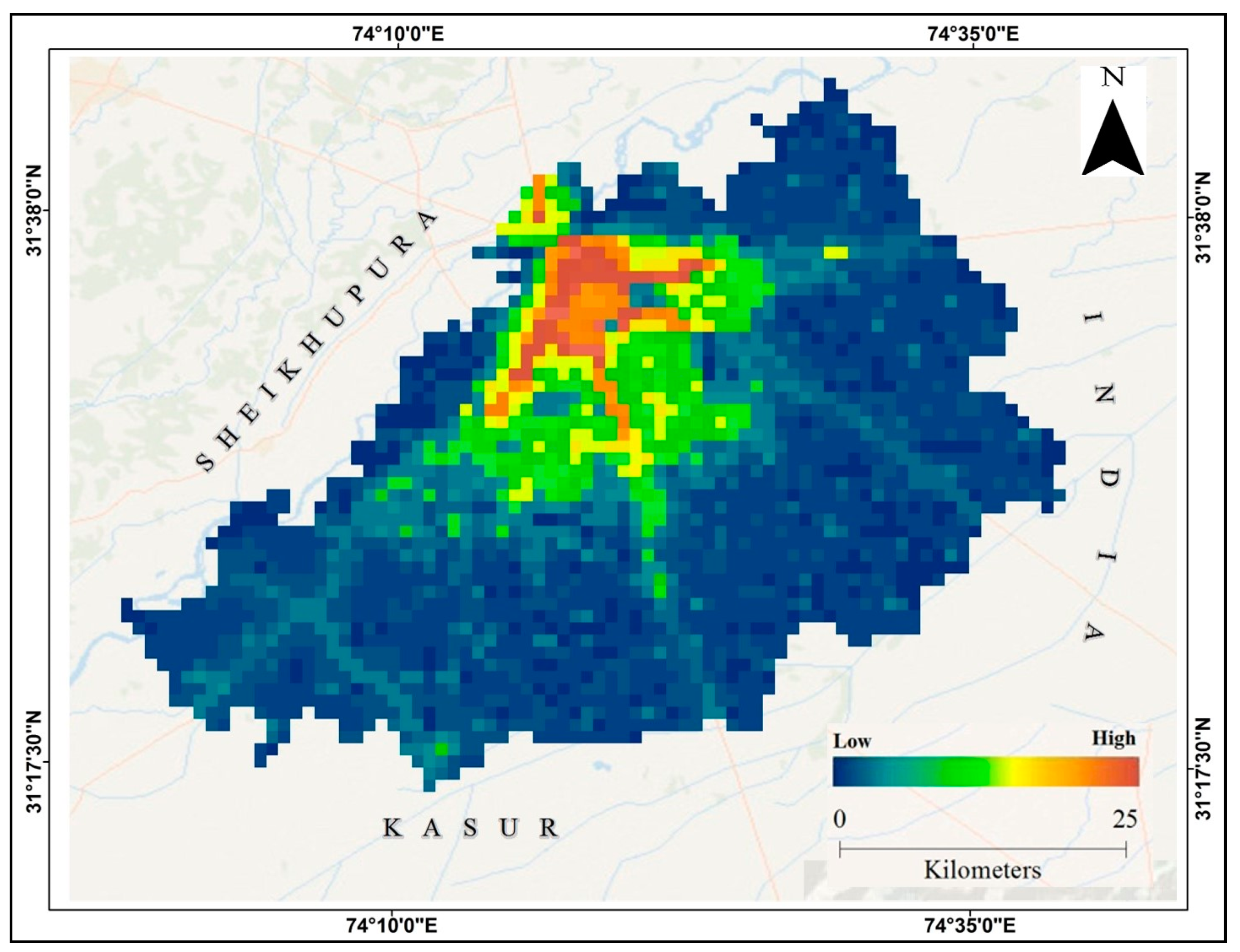
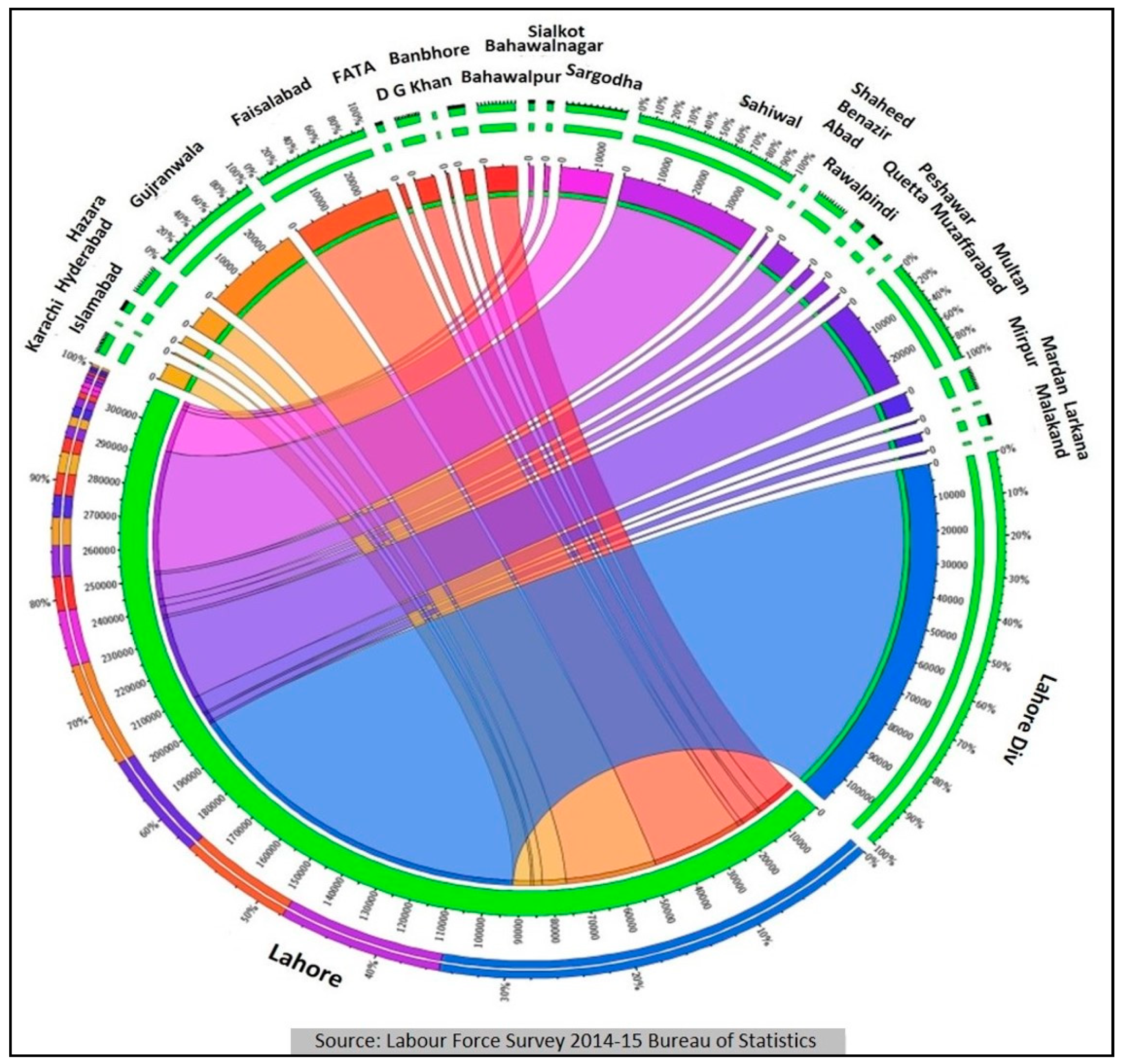
| Class | NDVI Range |
|---|---|
| Water | −0.28–0.015 |
| Built-up | 0.015–0.14 |
| Barren Land | 0.14–0.18 |
| Shrub and Grassland | 0.18–0.27 |
| Sparse Vegetation | 0.27–0.36 |
| Dense Vegetation | 0.36–0.74 |
| Landsat LULC Classes | Total Count | User’s Accuracy | |||||||
|---|---|---|---|---|---|---|---|---|---|
| Water Bodies | Built-up | Barren Land | Shrub and Grassland | Sparse Vegetation | Dense Vegetation | ||||
| Classified LULC Classes | Water Bodies | 280 | 0 | 0 | 0 | 0 | 0 | 280 | 100% |
| Built-up | 9 | 269 | 38 | 0 | 0 | 0 | 316 | 85.12% | |
| Barren Land | 1 | 31 | 260 | 11 | 0 | 1 | 304 | 86% | |
| Shrub and Grassland | 10 | 0 | 0 | 289 | 20 | 2 | 321 | 90.03% | |
| Sparse Vegetation | 0 | 0 | 0 | 0 | 250 | 20 | 270 | 92.59% | |
| Dense Vegetation | 0 | 0 | 2 | 0 | 30 | 277 | 309 | 89.64% | |
| Total Count | 300 | 300 | 300 | 300 | 300 | 300 | 1800 | 100% | |
| Producer’s Accuracy | 93.33% | 90% | 87% | 96% | 83.33% | 92.33% | |||
| Landsat LULC Classes | Total Count | User’s Accuracy | |||||||
|---|---|---|---|---|---|---|---|---|---|
| Water Bodies | Built-up | Barren Land | Shrub and Grassland | Sparse Vegetation | Dense Vegetation | ||||
| Classified LULC Classes | Water Bodies | 292 | 0 | 0 | 0 | 0 | 0 | 292 | 100% |
| Built-up | 1 | 275 | 10 | 0 | 0 | 0 | 286 | 96.15% | |
| Barren Land | 7 | 24 | 282 | 5 | 0 | 3 | 321 | 88% | |
| Shrub and Grassland | 0 | 1 | 1 | 289 | 10 | 5 | 306 | 94.44% | |
| Sparse Vegetation | 0 | 0 | 4 | 6 | 284 | 2 | 296 | 95.94% | |
| Dense Vegetation | 0 | 0 | 3 | 0 | 6 | 290 | 299 | 96.98% | |
| Total Count | 300 | 300 | 300 | 300 | 300 | 300 | 1800 | 100% | |
| Producer’s Accuracy | 97.3% | 92% | 94% | 96% | 94.66% | 96.66% | |||
| 1988 | 2001 | |||||
|---|---|---|---|---|---|---|
| Water | Built-up | Barren Land | Shrub and Grassland | Sparse Vegetation | Dense Vegetation | |
| Water | 4.26 | 3.98 | 6.79 | 5.48 | 2.34 | 2.53 |
| Built-up | 5.38 | 102.19 | 21.81 | 19.71 | 10.91 | 8.27 |
| Barren Land | 6.37 | 57.34 | 105.09 | 135.71 | 95.40 | 114.22 |
| Shrub and Grassland | 2.25 | 61.93 | 57.72 | 140.67 | 126.72 | 150.17 |
| Sparse Vegetation | 0.37 | 18.49 | 27.20 | 74.52 | 80.19 | 119.18 |
| Dense Vegetation | 0.33 | 8.71 | 19.43 | 44.00 | 44.47 | 74.57 |
| Water | Built-Up | Barren Land | Shrub and Grassland | Sparse Vegetation | Dense Vegetation | |
|---|---|---|---|---|---|---|
| Water | 0.168 | 0.157 | 0.268 | 0.216 | 0.092 | 0.100 |
| Built-up | 0.000 | 1.000 | 0.000 | 0.000 | 0.000 | 0.000 |
| Barren Land | 0.012 | 0.112 | 0.204 | 0.264 | 0.186 | 0.222 |
| Shrub and Grassland | 0.004 | 0.115 | 0.107 | 0.261 | 0.235 | 0.278 |
| Sparse Vegetation | 0.001 | 0.058 | 0.085 | 0.233 | 0.251 | 0.372 |
| Dense Vegetation | 0.002 | 0.045 | 0.101 | 0.230 | 0.232 | 0.389 |
| Water | Built-up | Barren Land | Shrub and Grassland | Sparse Vegetation | Dense Vegetation | |
|---|---|---|---|---|---|---|
| 1988 | 25.37 | 168.29 | 514.13 | 539.46 | 319.96 | 191.51 |
| 2001 | 13.58 | 318.74 | 216.22 | 400.38 | 349.12 | 460.67 |
| 2014 | 7.82 | 432.07 | 167.08 | 351.57 | 329.90 | 470.27 |
| 2027 | 6.04 | 532.74 | 149.61 | 322.36 | 306.19 | 441.77 |
| 2040 | 5.32 | 625.16 | 137.53 | 297.68 | 283.37 | 409.65 |
© 2019 by the authors. Licensee MDPI, Basel, Switzerland. This article is an open access article distributed under the terms and conditions of the Creative Commons Attribution (CC BY) license (http://creativecommons.org/licenses/by/4.0/).
Share and Cite
Akbar, T.A.; Hassan, Q.K.; Ishaq, S.; Batool, M.; Butt, H.J.; Jabbar, H. Investigative Spatial Distribution and Modelling of Existing and Future Urban Land Changes and Its Impact on Urbanization and Economy. Remote Sens. 2019, 11, 105. https://doi.org/10.3390/rs11020105
Akbar TA, Hassan QK, Ishaq S, Batool M, Butt HJ, Jabbar H. Investigative Spatial Distribution and Modelling of Existing and Future Urban Land Changes and Its Impact on Urbanization and Economy. Remote Sensing. 2019; 11(2):105. https://doi.org/10.3390/rs11020105
Chicago/Turabian StyleAkbar, Tahir Ali, Quazi K. Hassan, Sana Ishaq, Maleeha Batool, Hira Jannat Butt, and Hira Jabbar. 2019. "Investigative Spatial Distribution and Modelling of Existing and Future Urban Land Changes and Its Impact on Urbanization and Economy" Remote Sensing 11, no. 2: 105. https://doi.org/10.3390/rs11020105
APA StyleAkbar, T. A., Hassan, Q. K., Ishaq, S., Batool, M., Butt, H. J., & Jabbar, H. (2019). Investigative Spatial Distribution and Modelling of Existing and Future Urban Land Changes and Its Impact on Urbanization and Economy. Remote Sensing, 11(2), 105. https://doi.org/10.3390/rs11020105






